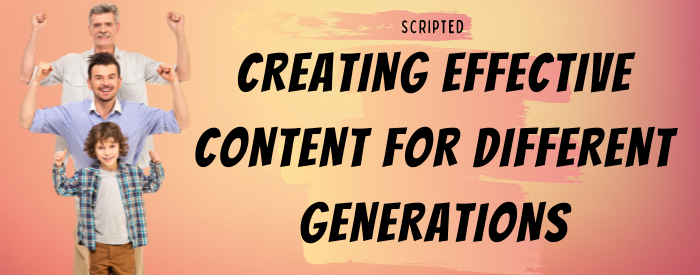- Blog Home
- Content Marketing
- Ciara Antolini
- Creating Effective Content For Different Generations
Creating Effective Content for Different Generations

Great writing is purposeful and directed towards a specific target audience. One way to organize an article is to target the demographic of your readership by segmenting according to audience age group. Excellent marketing campaigns keep the specific needs of different generations in mind and focus on providing age-appropriate solutions using communication strategies that are especially effective for each audience age group.
If you want to reach your audience emotionally, you need to understand what they value and where they come from. Different age groups have different emotional needs and interests, so it's important to know who you're writing for when you create content. That's why you have to target content to your audience's unique generation. What resonates with a Baby Boomer might not be as appealing for a Millennial.
Recommended Reading: Social Psychology and Marketing Tactics
Baby Boomers
People born between 1946 and 1964 are referred to as Baby Boomers due to a mass increase in births after World War II. Baby boomers were raised by parents who had seen the horrors of the war and wanted better for their children. They were raised to believe in their own prosperity while witnessing their world change dramatically during the turbulent 1960s. They used rotary dial phones and many didn’t have television. Radio was a popular form of media entertainment for many Boomers. Letter writing was a common form of communication between friends and family. They lived through the Vietnam war era and experienced the rise of the Civil Rights movement and the rise of women’s liberation movements first-hand.
Since so much has changed since the world they came to maturity in, they value stability. Some are nostalgic for the world of their childhood and feel that some generations today don't hold the same values they were raised with.
To appeal to this generation: Content should reflect traditional values, the importance of family, and the continuation of the American dream in a world of uncertainty. When your content reflects these values, Baby Boomers feel more secure and optimistic.
Recommended Reading: How to Evoke Nostalgia Through Your Written Content
Generation X
Generation X—the boomerang generation—is comprised of people who were born in the 1960s and 1970s. They were raised with the idea that they could be whoever they wanted to be.
Many Generation X-ers wound up moving back in with their families after their career path didn't work out or were downsized during tough economic times. Generation X-ers often have a negative view of the world due to the impacts of political events when they were coming of age, and many being the products of divorce and tough economic times. They also grew up with rotary dial phones. Friends mailed postcards and letters to one another. The digital transformation had not yet happened during their formative years.
To appeal to this generation: Many people of this generation are established in their careers and are parents who want their kids to be successful and proud of themselves. Content that stresses the importance of individuals encourages people to be themselves, and inspires pride in standing apart from the crowd will appeal to this generation.
Millennials— a.k.a. Generation Y
Generation Y, or the millennial generation, is comprised of people who were born between 1980 and 2000. They are the younger employees in the workforce. They tend to be well-educated, are idealistic, and technologically savvy. Although some research suggests this generation feels "entitled,", Generation Y-ers actually tend to have a different outlook due to their web-savviness and their need to feel they make a difference. Millennials are comfortable with digital technology and have curiosity about exploring new technology.
Generation Y is full of people who expect a lot from the world. They may be disappointed with the country's status quo and are more likely to be active in politics or social movements.
To appeal to this generation: This generation values openness, fairness, and justice; content that appeals to these values is likely to grab their attention.
Generation Z
Generation Z is all grown up and entering the workforce, college, and universities, and they are paying attention to marketing materials. Generation Z is likely to be highly technologically savvy at a young age, and they are known for spending countless hours online. In addition, Generation Z is a skeptical generation. They are referred to as the loneliest generation and have expressed being highly emotional. Members feel that adults have left a mess in the world they will soon inherit and are hyper-sensitive to any attempt to trick or pressure them into buying anything.
To appeal to this generation: Content that makes members feel more secure and more connected to people that are like them is welcome. They value honesty and transparency in communication and do not like trickery.
Advertising and Marketing According to Audience Age Groups
Marketing strategies can be streamlined to focus on generations depending on who the target audience of your product or service is. Different strategies appeal to each group. Each has a different comfort level with technology and digital marketing campaigns. There are also trends in marketing that affect all age groups and one trend right now is the search for more meaning and more honesty in marketing.
Audiences have spoken and the feedback they have given companies via chatbots, emails, feedback forms, and social media comments is clear: Offering solutions to their problems in advertising only matters to them if the solutions are authentic, meaningful, and true. Audiences of all ages have become less tolerant of hyperbole and absurdist advertising designed to entertain.
When developing your social media marketing strategy or your content marketing strategy keep some of the following tips in mind.
Boomers
Boomers respond well to appeals to emotion in marketing. They love nostalgic commercialism, all things vintage, and being reminded of days gone by. They love the words ‘classic’ and ‘traditional.’ Boomers appreciate content that reassures them about security and future success. They are likely to look more at online ads that tell a story or solve a problem, like a blog post. They are less interested in other forms of digital media. They appreciate blog posts that tell a story about history or that teach them something new about ideas.
Generation X
Generation X appears to appreciate many of the same techniques as Boomers do in advertising. They, too, like ‘vintage’ and ‘shabby chic.’ They appreciate solutions to the problems they're facing in marriage, parenting, and career mobility. They are looking for ways to invest their money wisely and have an eye on retirement goals. Gen X loves humor in advertising and memes they can share on Facebook. They get a kick out of questionnaires that tell them something about themselves and they respond to online contests. Blog posts that give instructions for projects like How-To articles, recipes, and DIY projects are very appealing to Gen X.
Millennials and Gen Y
The younger generations like everything to happen quickly in advertising and marketing. They want the details about products and pricing right up front and in bulleted point form. They like comment sections and the ability to leave a review or a rating. These generations do not like aggressive sales pitches or any type of exaggeration in marketing techniques. Offering something free catches their attention and online coupons are popular with them. They appreciate blog posts that respect the challenges of their age groups and that offer reasonable and clear solutions. Blogs that incorporate brief video clips, many images, and bulleted and numbered lists are appreciated. They also appreciate blog posts that explain how things work and that give straightforward facts about unique and interesting topics.
Effective Workplace Communication Across Generations
It can be challenging to create workplace communication documents that catch the attention of all employees regardless of their generation. Your goal in the workplace is to be inclusive, so the strategy differs slightly from marketing where you might be focused on only communicating with the youth, or specifically communicating with the older generation. There are Boomers working shoulder to shoulder with Millennials and Generation Y-ers, and remote work teams consist of members of diverse age groups.
Here are some suggestions for best workplace communication practices to reach each generation:
Boomers
In spite of the digital revolution, Boomers really appreciate paper communication. Memos, newsletters, bulletins, and meeting minutes all appeal to them more when printed off on paper. They have learned the ins and outs of business email but are not keen on apps and social media in the workplace, although they are learning every day to adjust to the digital transformation in business. They do have the longest attention span to read lengthy whitepapers and technical documents that younger generations may lack. They are not all on Facebook or LinkedIn, so being available to help them create those profiles, perhaps by teaming them up with a younger colleague, is a good time investment.
Generation X
Gen X is proud of all they have learned about technology and the workplace. They generally have at least one social media platform presence. They are comfortable with both paper communication and digital copies of workplace memos. They prefer online meetings to in-person sit-downs. They are proficient in accessing Facebook and Twitter accounts and generally have a Linkedin profile, too.
Millennials and Gen Y
Hire a Scripted Professional Writer to Reach Your Target Audience
In addition to being expert writers and specialists in their industry knowledge, Scripted writers are also highly informed about market segmentation based on generations and know how to direct communication to each specific age group. Whether you're expanding your social media reach or looking to create a workplace communication document, a Scripted writer can expertly fine-tune your message to reach a specific age group or as wide an audience as possible. Contact us today to order social posts from Scripted writers.
Published by Ciara Antolini on Friday, February 21, 2014 in Content Marketing, Content Marketing, Trends.






